

English Grammar lessons. ESL Grammar Conversation Questions. Difference between conjunctions, relative pronouns and relative adverbs. Conjunctions, relative pronouns and relative adverbs can be used to connect two clauses.
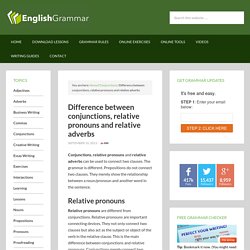
The grammar is different. Prepositions do not connect two clauses. They merely show the relationship between a noun/pronoun and another word in the sentence. Relative pronouns Relative pronouns are different from conjunctions. Study the sentences given below. This is the letter. We can connect these two clauses. This is the letter that my mother sent me. Here the relative pronoun that replaces the phrase this letter and acts as the object of the verb sent. Relative Pronouns Exercises. Relative Pronouns. Like any pronoun, relative pronouns are substituted for nouns and other pronouns that functions as subjects or objects in a sentence.
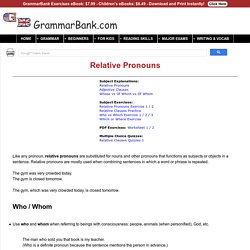
Relative pronouns are mostly used when combining sentences in which a word or phrase is repeated. The gym was very crowded today.The gym is closed tomorrow. The gym, which was very crowded today, is closed tomorrow. Who / Whom Use who and whom when referring to beings with consciousness: people, animals (when personified), God, etc.The man who sold you that book is my teacher. Relative Pronouns 2. Relative Pronouns. Difference between conjunctions, relative pronouns and relative adverbs. So / Such. The following is a mini-tutorial on the use of "so" and "such.

" After you have studied the tutorial, complete the associated exercises. If you already know how to use "so" and "such," you can skip the explanation and go directly to the exercises. So + Adjective "So" can be combined with adjectives to show extremes. This form is often used in exclamations. Examples: The music is so loud! USE with "That" The above form can be combined with "that" to show extremes which lead to certain results. The music is so loud that I can't sleep. So + Adverb "So" can be combined with adverbs to show extreme actions. She spoke so quickly! Conjunctions: and, or, but, so, because and although. Daisy: Are you and Alfie going to the festival this weekend?

Oliver: Hmm? We want to, but we don't have a car so we're not sure how to get there. It's in the middle of nowhere! Daisy: Amy's dad is taking us on Saturday morning, and he's offered to bring us home again on Sunday. Why not come with us? CONJUNCTIONS. Conjunctions are words used as joiners.
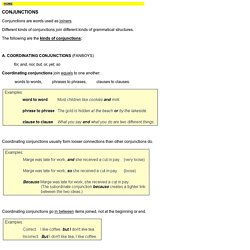
Different kinds of conjunctions join different kinds of grammatical structures. The following are the kinds of conjunctions: for, and, nor, but, or, yet, so Coordinating conjunctions join equals to one another: words to words, phrases to phrases, clauses to clauses. Coordinating conjunctions usually form looser connections than other conjunctions do. Coordinating conjunctions go in between items joined, not at the beginning or end. Conjunctions. What are conjunctions?
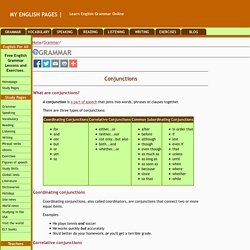
A conjunction is a part of speech that joins two words, phrases or clauses together. There are three types of conjunctions: Coordinating conjunctions Coordinating conjunctions, also called coordinators, are conjunctions that connect two or more equal items. Examples: He plays tennis and soccer He works quickly but accurately You'd better do your homework, or you'll get a terrible grade. Conjunctions. Conjunctions are used to join words or groups of words together.

The most common ones are and, or, and but. (There are many others.) Read more about conjunctions in the glossary of terms. Conjunctions can be categorized into one of three groupings: Coordinating conjunctions are the ones that spring to mind when people think about conjunctions. Who, Whom, Whose. The following is a mini-tutorial on the uses of "who," "whom," and "whose.

" If you already know how to use these words, you can skip the explanation and go directly to the exercises. Subjects, Objects and Possessive Forms To understand how to use "who," "whom," and "whose," you first have to understand the difference between subjects, objects, and possessive forms. Subjects do an action: He loves movies. Objects receive an action: The teachers like him. Possessive forms tell us the person something belongs to: There is OR There are a boy, a girl and an old man...?
There is/are? 20 Rules of Subject Verb Agreement. While grammar is not as static a science as is typically assumed, there are 20 rules of subject verb agreement that attempt to objectify part of the English language form.
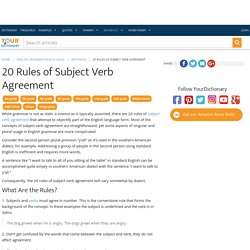
Most of the concepts of subject verb agreement are straightforward, yet some aspects of singular and plural usage in English grammar are more complicated. Consider the second person plural pronoun "y'all" as it's used in the southern American dialect, for example. Addressing a group of people in the second person using standard English is inefficient and requires more words. A sentence like "I want to talk to all of you sitting at the table" in standard English can be accomplished quite simply in southern American dialect with the sentence "I want to talk to y'all.
" Consequently, the 20 rules of subject verb agreement will vary somewhat by dialect.
Verb Tenses. Phrasal Verbs.